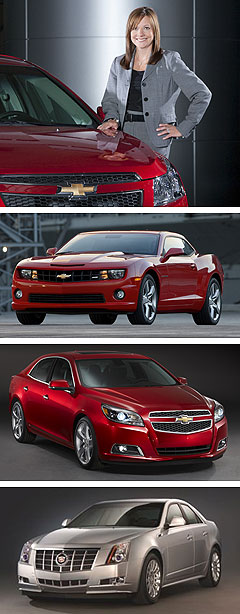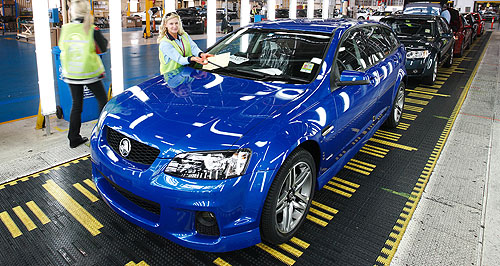Future models - Holden - CommodoreGM to slash vehicle platformsAdelaide-made: Holden's Commodore appears set to remain rear-drive into the next decade. Holden set to win RWD program as GM hones range to 14 ‘core’ platforms11 Aug 2011 A HOLDEN-developed rear-wheel drive platform appears to have made the cut in General Motors’ master list of 14 core global vehicle architectures that will spawn 90 per cent of GM cars and light trucks by 2018. The American giant last night announced it would slash the number of its platforms by more than half as it rationalises the current 30 architectures – two-thirds of them regional models – to reduce complexity, improve products and save up to $1 billion a year in engineering costs. A graphic shown in Detroit by GM senior vice-president global product planning Mary Barra to illustrate the plan reveals no reduction in the number of medium and large sedan platforms after 2014, when the new VF Commodore based on the current Zeta platform is set to emerge. This raises hopes that that one of the vehicles to make the grade for 2018 might be a locally engineered next-generation architecture for future Commodores and derivatives to be sold on a global scale. GM Holden has added to the optimism, with senior product communications manager Jonathan Rose telling GoAuto: “We’re continuing to develop future Commodore models for the Australian market and work on other global RWD projects – which with cars like Camaro have been very successful in the past. “We are absolutely committed to designing, engineering and building vehicles right here in Australia. There's no change to that approach.” A decision on the long-term future of Holden’s big sedan was expected this year, with GM Holden chairman and managing director Mike Devereux telling GoAuto last December that the call would have to be made within 12 months. The newly announced major shake-up for GM – which in many ways mirrors the Blue Oval’s One Ford strategy – was spelled out by the company’s most senior executives at the GM Global Business Conference for US investors and financial analysts last night. Ms Barra said GM would streamline its architectures and invest in new products regardless of the prevailing business conditions to reduce the impact on the company of what she described as “churn” – inefficient new model development. She said stop-start projects, project cancellations, late scope changes and lead engineering management changes had bled GM of up to $1 billion a year.  Left: GM global product development chief Mary Barra. Below: Chevrolet Camaro, Chevrolet Malibu, Cadillac CTS. Left: GM global product development chief Mary Barra. Below: Chevrolet Camaro, Chevrolet Malibu, Cadillac CTS.Ms Barra said reducing the “number of mouths to feed” in the GM architecture line-up would mean more robust architectures, reduced tooling cost and greater volume leverage off each platform. The result for the company would be the ability to bring more new products to market quickly, with improved quality and reliability. While Ms Barra did not name the planned platforms or spell out which models they would spawn, a slide presented with her speech showed what appeared to be three small cars, three medium and large sedans, a sportscar, four SUVs/people-movers, two pick-ups and a van. The graphic showed how current ‘regional’ platforms would be discontinued or merged to create 24 architectures by 2014 – with 13 core platforms – and then to 14 core platforms by 2018. As Holden has already confirmed the Commodore will exist beyond 2014 in the re-designed VF, we can assume that one of the large sedans in the 2014 column represents that model. The 2018 column carries matching models in the medium-large sedan segment, with one of them graduating from ‘regional’ to ‘core’. The plan gives no hint whether the vehicles shown in the graphic will be front- or rear-wheel drive, but speculation in the United States suggests at least one large rear-drive passenger car architecture will survive, underpinning vehicles such as the Cadillac CTS and STS and Chevrolet Camaro muscle car. The current Camaro is built on the Holden-developed Zeta platform. It is unclear if the Zeta platform will continue in a new generation or if another rear-drive architecture – possibly the rumoured Alpha design – might replace it to cover all rear-drive bases by 2018. As GoAuto reported in December, the future of Commodore as a rear-drive proposition was uncertain in 2010, with pressure coming from some quarters in GM to migrate the big Aussie sedan on to a GM front-drive platform from about 2018-20. One theory was that a stretched version of the Opel-developed Epsilon front-drive platform – called Super Epsilon – would be developed for a range of GM large cars, including the Commodore and Chevrolet Impala. US magazine Motor Trend speculated that the Super Epsilon platform was being engineered in Australia – a report denied by Holden sources speaking to GoAuto. The current Epsilon II platform underpins the European Insignia and Korean-built Malibu – both of which are set to go on sale in Australia within the next 12 months under Opel and Holden badges respectively. That platform is almost certain to live on in new generations under the latest GM architecture roll-out to 2018, along with several other familiar architectures such as the Gamma (Barina, Corsa, Aveo), Delta (Cruze, Volt, Astra, Ampera) and Theta (Captiva, Cadillac SRX and Opel Antara). Two pick-up architectures have been locked in, probably including one platform for the Colorado that is set to become a global vehicle in the next few years, and a full-size pick-up for the big Chevrolet Silverado and derivatives that GM requires in the North America. As part of the culling announced by GM, the engine line-up also will be halved to 10 powertrains over the next decade, again to save costs from the current scatter-gun approach. Those engines almost certainly will include a V6, which should ensure continued production at Holden’s engine factory at Port Melbourne. GM says in its new plan that 80 per cent of incremental vehicle production between 2015 and 2018 will be given to low-cost countries such as China, Mexico, India and Russia, while the remainder would be split between “medium-cost” countries such as South Korea and Argentina, “high-cost” countries such as the US, Australia, Canada, UK and Germany.  Read more19th of May 2011  Holden to dress Commodore in aluminiumCommodore to get aluminium panels and electric steering as Holden greens large carCommodore pricing
Motor industry news |
Click to shareHolden modelsCommodore pricing
Motor industry news |
















Facebook Twitter Instagram